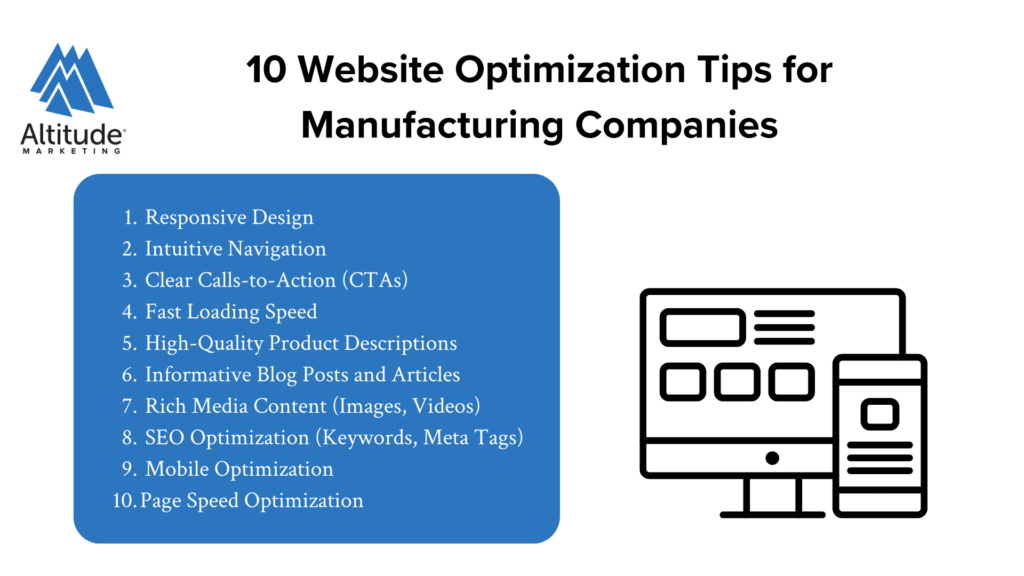A well-designed, functioning website is now a must for any brand, no matter how niche the industry. As a B2B manufacturer, your web presence might be minimal, and most of your business might be conducted offline, but there are still two crucial reasons you need to build and maintain a best-in-class digital presence.
- Your website is your frontline reference. A slow, outdated, or frustrating user experience reflects poorly on the products and services you provide.
- Google penalizes bad websites. Unless you have a top-notch technical engine and useful, up-to-date content, you risk losing valuable SEO real estate.
This guide will provide comprehensive insights and practical advice to help manufacturing companies enhance their online presence. Whether you’re a small machine shop or a large-scale manufacturing enterprise, implementing these website optimization tips can significantly improve your online success. Here’s how you can take your manufacturing website to the next level with actionable strategies, split into two categories: user experience (UX) and content.

10 Website Optimization Tips for Manufacturing Companies
User Experience Optimization
User Experience (UX) encompasses how your users interact with your website. That includes everything from responsive design, intuitive navigation, clear CTAs, and fast loading speed. Design that emphasizes easy navigation and speed will help ensure your website matches best-in-class standards. You can do this through:
1. Responsive Design:
Responsive design ensures that your website is accessible and functional across various devices and screen sizes, including desktops, laptops, tablets, and smartphones. With the increasing use of mobile devices for browsing the internet, responsive design is essential to provide a seamless and consistent user experience, regardless of the device used.
Implementation Tips:
- Utilize a mobile-responsive website theme or template.
- Test your website’s responsiveness across different devices and screen sizes.
- Optimize images and media files for faster loading on mobile devices.
- Prioritize content hierarchy for mobile users, keeping essential information visible and accessible.
2. Intuitive Navigation:
Intuitive navigation ensures that visitors can easily find the information they’re looking for and navigate through your website effortlessly. Clear and intuitive navigation reduces bounce rates, keeps visitors engaged, and improves overall user satisfaction.
Implementation Tips:
- Keep the navigation menu simple and organized, with clear labels and categories.
- Use descriptive and user-friendly language for navigation links.
- Include a search bar to allow visitors to quickly find specific content.
- Use breadcrumbs to indicate the user’s current location within the website hierarchy.
3. Clear Calls-to-Action (CTAs):
Calls-to-action (CTAs) prompt visitors to take a specific action, such as contacting your company, requesting a quote, or downloading a resource.
Clear and compelling CTAs guide visitors through the conversion funnel and encourage them to engage further with your website.
Implementation Tips:
- Use action-oriented language that prompts immediate response (e.g., “Get Started,” “Request a Quote,” “Download Now”).
- Make CTAs visually prominent with contrasting colors and strategic placement on the page.
- Ensure that CTAs are relevant to the content and context of the page.
- Test different variations of CTAs to identify which ones resonate best with your audience.
4. Fast Loading Speed:
Fast loading speed is crucial for providing a positive user experience and reducing bounce rates. Visitors expect websites to load quickly, and slow-loading pages can lead to frustration and abandonment.
Improved loading speed not only enhances user experience but also positively impacts search engine rankings and overall website performance.
Implementation Tips:
- Optimize images and multimedia content to reduce file sizes.
- Minimize HTTP requests by combining CSS and JavaScript files.
- Enable browser caching to store static resources locally and reduce load times for returning visitors.
- Use a content delivery network (CDN) to distribute content across multiple servers and improve loading speed for users in different geographical locations.
Content Optimization
Content optimization is crucial for enhancing online visibility, engaging audiences, and driving traffic to your website. Here’s a breakdown of key components:
5. High-Quality Product Descriptions:
- Provide detailed information about products/services.
- Highlight unique selling points.
- Use persuasive language to encourage conversions.
- Ensure clarity and accuracy to minimize returns or misunderstandings.
6. Informative Blog Posts and Articles:
- Address relevant topics within your industry or niche.
- Offer valuable insights, tips, or solutions to audience queries.
- Establish authority and credibility in your field.
- Encourage social sharing and backlinks from other websites.
7. Rich Media Content (Images, Videos):
- Enhance user experience and engagement. Do this via multimedia content that attracts viewers.
- Showcase products from different angles (images).
- Demonstrate product features or how-tos (videos).
- Optimize images for fast loading and include descriptive alt text for SEO.
8. SEO Optimization (Keywords, Meta Tags):
- Research and incorporate relevant keywords throughout the content.
- Optimize meta titles and descriptions for search visibility.
- Use structured data markup to enhance search results.
- Ensure website speed and mobile-friendliness for improved user experience and SEO ranking.
By incorporating these elements into your content strategy, you can improve your website’s visibility, attract more traffic, and ultimately increase conversions. Regularly monitor and analyze performance metrics to refine your approach and stay competitive .
Technical optimization plays a critical role in ensuring your website performs well and ranks favorably in search engine results. Here’s how each component contributes to technical optimization:
9. Mobile Optimization:
Ensure your website is responsive and displays correctly on various devices and screen sizes. Prioritize mobile user experience, including easy navigation and fast loading times.
Test your site across different mobile devices and browsers to identify and fix any issues.
10. Page Speed Optimization:
Optimize images and multimedia content to reduce file sizes without compromising quality. Minimize HTTP requests by combining and compressing CSS and JavaScript files.
Leverage browser caching and enable server compression to decrease loading times. Use a content delivery network (CDN) to deliver content faster to users across different geographic locations.
Frequently Asked Questions
Why is website optimization important for manufacturing companies?
Website optimization is crucial for manufacturing companies to enhance their online presence, attract potential customers, and drive business growth. It ensures that their website is easily discoverable, and user-friendly, and provides valuable information to visitors
How can high-quality product descriptions benefit my manufacturing company's website?
High-quality product descriptions can help showcase your products effectively, highlight unique features, and persuade potential customers to make a purchase. Detailed descriptions also improve search engine visibility by incorporating relevant keywords.
What role does SEO optimization play in the success of a manufacturing company's website?
SEO optimization helps improve your website’s visibility in search engine results, making it easier for potential customers to find you online. By incorporating relevant keywords, optimizing meta tags, and enhancing technical elements, you can attract more organic traffic and increase conversions.
Conclusion
Effective website optimization strategies enable manufacturing companies to establish a strong online presence that not only showcases their products and services but also positions them as industry leaders. Through compelling product descriptions, informative blog posts, and engaging rich media content, manufacturing companies can effectively communicate their value proposition and expertise to their target audience.




